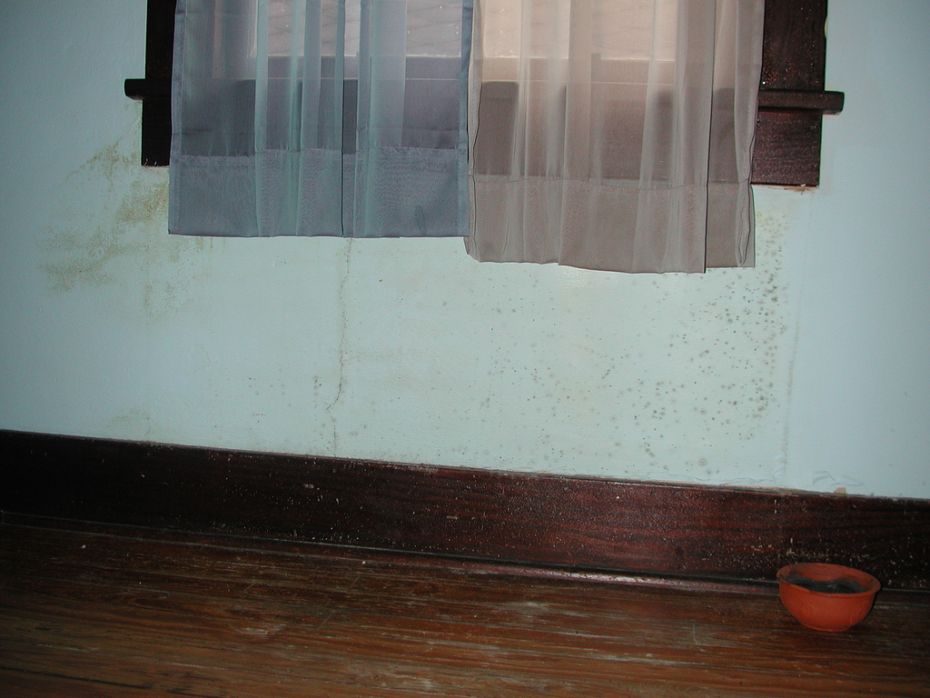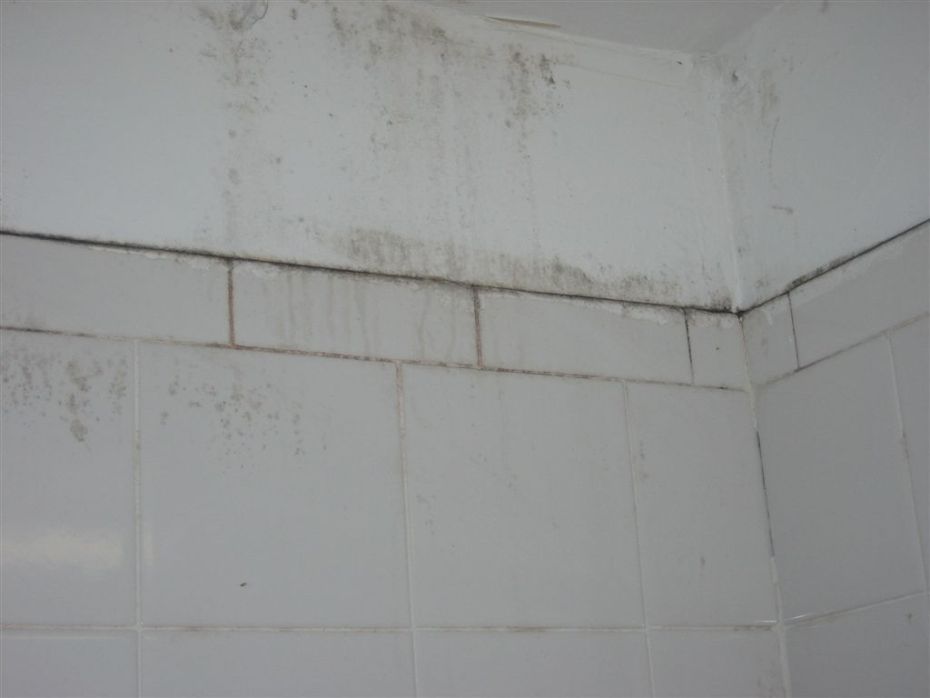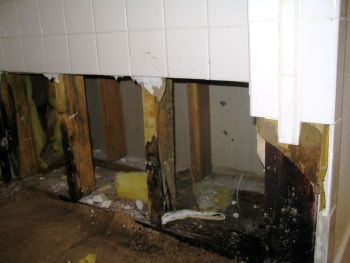
Although mold is sometimes nothing more than an eyesore, it can also prove to be a serious health risk.

When a flood strikes your property, it brings a whole host of difficulties. Not only is there the flood itself, and the danger of rising or rushing water to contend with, but after the water recedes, the flood leaves behind a trail of damage ranging in seriousness from life threatening to simple nuisances. Mold is one of these after-effects of flooding. While sometimes it only proves to be an unsightly nuisance, mold can also pose a very serious health risk at times.
Mold is a type of fungus and it comes in many varieties. Although there are always mold spores in the air around us, when these spores encounter a damp environment and organic matter to feed on, they reproduce at a rapid rate, quickly establishing a mold colony. After a flood, damp buildings contain the exact conditions that mold needs to flourish.
Health Effects
There are a multitude of different types of mold, ranging from varieties that merely represent an ugly eyesore to types that scientists believe cause serious illness. Unfortunately, there is still a lot that is unknown about mold, especially about its health effects on humans. Although people hold many beliefs about mold, experts have only proven links to specific health problems in relatively few cases thus far. However, mold is a high priority for researchers, and it is very likely that they will continue to make progress uncovering its secrets.
According to the Centers for Disease Control, mold exposure has been linked to respiratory problems in people who were otherwise healthy. Mold has also been known to trigger asthma attacks and lung tissue inflammation in those who already displayed some susceptibility to those conditions. Research further indicates that children who are exposed to mold at a young age are more likely to suffer from asthma than those who do not encounter mold. Mold can also cause people with frail immune systems or chronic lung problems to develop infections, including fungal infections inside the lungs.
In addition to these known health effects, there have been many reports of molds releasing toxins that cause a variety of very serious health problems, like bleeding within the lungs. Although these links have not yet been scientifically proven, significant scientific study is currently focused on this topic.

In sufficiently damp conditions, mold only needs a day or two to establish significant growth.

Preventing Mold after a Flood
If your home floods, some parts of the structure may dry out fairly well on their own. However, it is highly unlikely that air-drying alone will sufficiently dry out your house. Unless you take immediate and thorough steps to clean and dry your home completely, some of your home’s building materials could remain damp long enough for mold to begin to grow. The window of time for cleanup is very short, as mold only needs a day or two to establish significant growth.
Unfortunately, in certain serious flood situations there simply might not be enough time to realistically clean and dry a house. However, in many cases of less-severe flooding, if you act immediately and get professional help you can often salvage your home’s building materials.
Any time that a flood occurs in your area and floodwater either comes close to your home or enters it, you should be on the alert for mold growth. Of course, if you're able to take preventative measures ahead of these situations, use sandbags, flood barriers, or other flood control devices to head off floodwater. However, if water actually does enter your home, get a flood remediation expert involved immediately, so they can begin a rapid cleanup and drying effort with powerful commercial fan systems. Even if the floodwater did not enter your home, increased groundwater saturation could have caused other moisture problems in your home, like water seeping into your basement or a sustained increase in your home’s humidity level. If there is an increase in groundwater volume entering your basement, keep a close eye on your home's sump pump, along with any backup systems that you may have, like a battery backup sump pump or water powered sump pump. Ensure that they activate properly when the float is triggered and that there are no clogs or damage that would inhibit the pumps' ability to remove water.
Signs of Mold

Regardless of whether a flood has struck your home or not, it is a good idea to keep a continual lookout for mold. Watch for signs that mold has entered your house, including the following.
If your home generally tends to have a high humidity level, greater than 55% for instance, your home is humid enough to promote mold growth. Take steps to address the humidity problem and investigate your home for signs of mold. Pay close attention to your basement or crawl space, since these areas tend to have lower temperatures, creating additional potential for condensation, as cooler air holds less moisture than warmer air.
If you detect musty odors inside your house, do not waste any time – find out the cause. Although this odor by itself does not necessarily indicate a mold problem, there is a chance that it ends up being the only warning sign you get that a hidden mold source exists on your property.
Examine your walls for warped wood or peeling paint, often indications that moisture has been trapped inside the walls. Stains or discoloration on the walls are another telltale sign of moisture damage. Water stains are often yellow in color, although if mold already exists, you could see brown, black, or green colors. Have a mold professional use a black light to tell if there is indeed mold on your walls.
In your bathroom, inspect the grout between tiles for mold. Since this grout is porous, water can enter it, allowing mold to grow. Check for cracks or gaps in the grout as well, as these provide additional opportunities for mold growth.
When you encounter mold on a hard surface like a tile, clean it completely with detergent, and dry it off. If mold is found in permeable surfaces like ceiling tiles, replace them, as mold could be living inside.
Keep an eye on the people in your household, for signs of health effects that might be mold-related, such as unexplained respiratory problems. If allergies, persistent coughing, other respiratory ailments seem to consistently take place or worsen in your home, then you might have mold somewhere. Black mold in particular is thought to produce dangerous compounds that affect people’s mucous membranes and central nervous system. Victims of this mold often complain about dizziness or headaches.
Preventing moisture problems in the first place is clearly the key to avoiding mold. However, if your home has experienced flooding, suffered from other types of water damage, or if you suspect that mold already exists on your property, it is too late for preventative measures. Get a professional involved immediately to clean and dry the water damaged areas or remediate any existing mold on your property. Toxic or otherwise harmful mold is a serious matter, and you cannot be too cautious when taking steps to ensure that your house is safe.
Source, Centers for Disease Control
Image sources: Bart Everson, Andrew Ratto, Paul Sableman, aimee rivers, and angela schmeidel randall
--------------
This article is intended for informational purposes. Before beginning any construction project at your home or taking steps to prepare for an emergency, please ensure that you take necessary safety precautions; consult construction professionals, your local authorities, and disaster safety experts whenever necessary.
